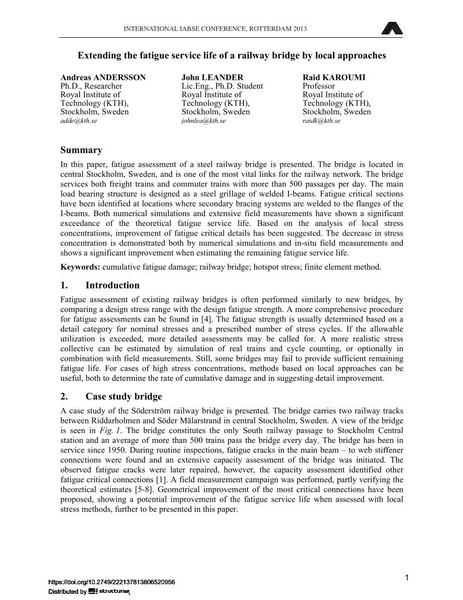Extending the fatigue service life of a railway bridge by local approaches

|
|
|||||||||||
Bibliografische Angaben
| Autor(en): |
Andreas Andersson
John Leander Raid Karoumi |
||||
|---|---|---|---|---|---|
| Medium: | Tagungsbeitrag | ||||
| Sprache(n): | Englisch | ||||
| Tagung: | IABSE Conference: Assessment, Upgrading and Refurbishment of Infrastructures, Rotterdam, The Netherlands, 6-8 May 2013 | ||||
| Veröffentlicht in: | IABSE Conference, Rotterdam, May 2013 | ||||
|
|||||
| Seite(n): | 444-445 | ||||
| Anzahl der Seiten (im PDF): | 8 | ||||
| Jahr: | 2013 | ||||
| DOI: | 10.2749/222137813806520956 | ||||
| Abstrakt: |
In this paper, fatigue assessment of a steel railway bridge is presented. The bridge is located in central Stockholm, Sweden, and is one of the most vital links for the railway network. The bridge services both freight trains and commuter trains with more than 500 passages per day. The main load bearing structure is designed as a steel grillage of welded I-beams. Fatigue critical sections have been identified at locations where secondary bracing systems are welded to the flanges of the I-beams. Both numerical simulations and extensive field measurements have shown a significant exceedance of the theoretical fatigue service life. Based on the analysis of local stress concentrations, improvement of fatigue critical details has been suggested. The decrease in stress concentration is demonstrated both by numerical simulations and in-situ field measurements and shows a significant improvement when estimating the remaining fatigue service life. |
||||
| Stichwörter: |
Finite-Elemente-Methode (FEM) FEM Eisenbahnbrücke
|
||||
